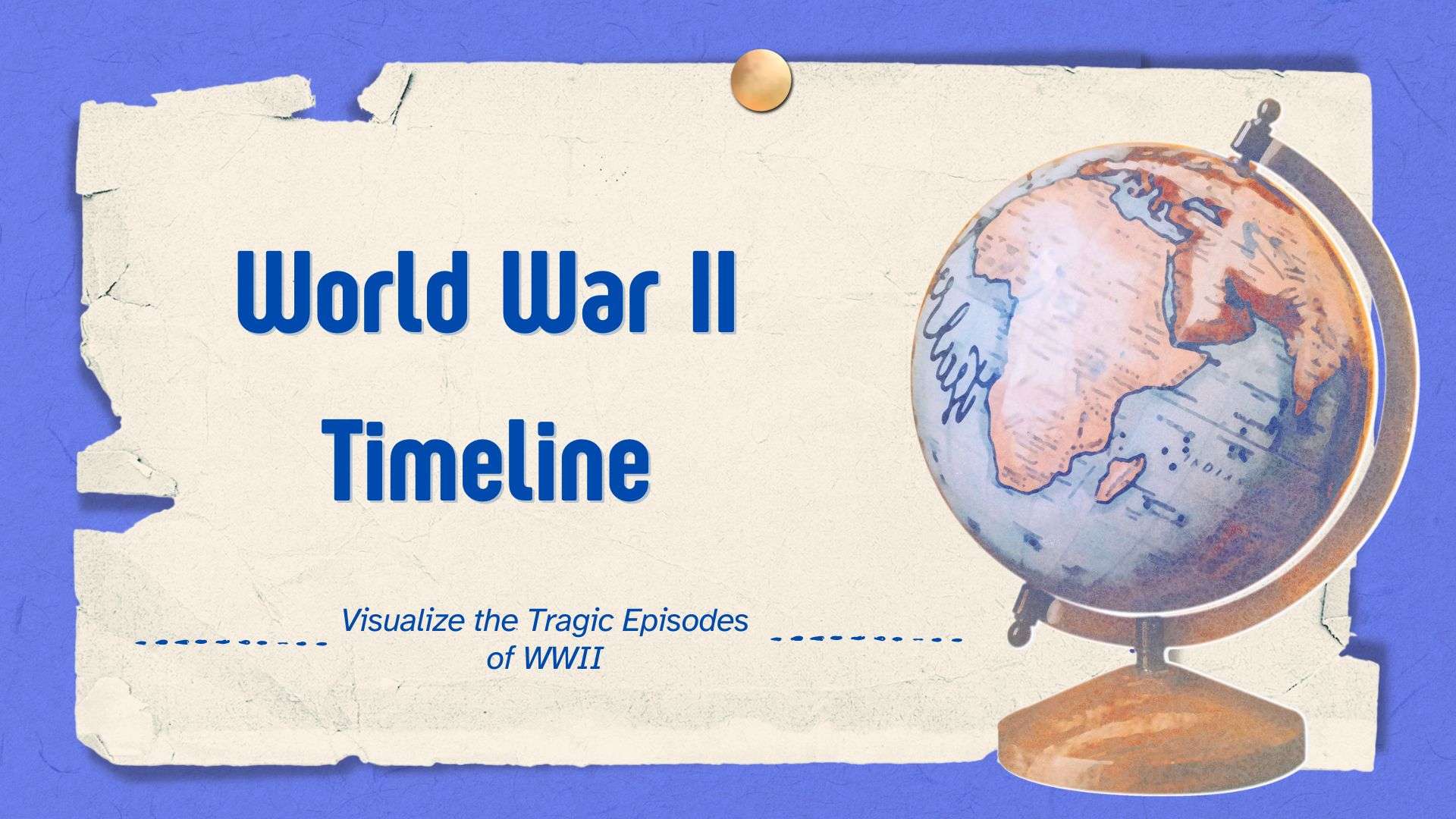The World War II timeline of events traces the major events that shaped World War II between 1937 and 1945. Explore similar examples from the EdrawMax template community.

World War II, undisputedly the bloodiest and biggest war in human history, was an aerial, naval, and land war fought between the Allies and the Axis. The war involved 50 nations and resulted in an estimated 80 million casualties. In retrospect, it was the inevitable consequence of the unresolved economic and political tensions of World War I and the Great Depression.
Today, it is studied to understand the horrors of military power and the importance of strategy. However, interweaved actors and simultaneous episodes across Europe, Africa, and the Pacific make it challenging for the human mind to comprehend. What’s better is a World War II timeline. This World War II chronology discovers the pivotal WWII events from 1937 to 1945 and traces the bitter conclusion of the Axis.
In this article
Part 1. World War II – Chronology
Explore the timeline of key events of World War II between 1937 and 1945. Discover how a minute miscalculation turned into an uncontrollable global war.
Complete Outbreak of World War II (1937-1941)
1937 - Japan Invaded Manchuria
As an extension of the Second Sino-Japanese War, Japan invaded the Chinese province of Manchuria. The expansion aimed to seek raw materials and fuel the industries at home.
September 1939 - German Invasion of Poland
Hitler invaded Poland in September, causing distress in Paris and London. France and Britain declared war on Germany two days later, declaring the start of WWII. One month before the invasion, Germany and the Soviet Union signed a Nonaggression Pact, declaring USSR military support for Germany following the Poland invasion.
Later, in September, the USSR invaded Poland from the east. The Polish government took refuge in Romania, France, and later in Great Britain. Germany and the Soviet Union divided Poland's territory between them.
December 1939 - UK Wins First Sea Battle
Amidst the tension, the British and German forces collide in a heated Battle of the River Plate. The UK defeated a German pocket battleship, declaring its first naval win.
April 1940 - Hitler Invaded Denmark and Norway
Germany invaded Denmark and Norway on Hitler’s orders, ending the six-month phony wars. Denmark surrendered the same day, while Norway showed resistance till June 9.
May/ June 1940 - Dunkirk Operation
The trapped British Expeditionary Forces evacuated the sea from Dunkirk to England. Meanwhile, Italy’s leader, Benito Mussolini, joined the Pact of Steel, allying with Germany against Britain and France.
Germany invaded Western Europe, notably France, Luxembourg, Belgium, and the Netherlands. France’s Northern territory remained under Hitler’s control.
July 1940 - Battle of Britain
Following the German’s continuous bombing against Britain in the Blitz, the Royal Air Force defeated the German Air Force (Luftwaffe) in the Battle of Britain. Moreover, Britain received US aid under the Lend-Lease Act.
Early 1941 - Italy and Germany Attack Yugoslavia
Bulgaria, Romania, and Hungary joined the Axis. Together, Germany, Italy, and Hungary invaded Yugoslavia. Yugoslavia surrendered on April 17, 1941.
Turning Tides (1941-1943)
June 1941 - Operation Barbarossa (Germany Attacks Russia)
Nazi Germany invaded the Soviet Union, known as Operation Barbarossa. Due to inadequate Russian Aviation technology, the German forces could advance 200 miles into Moscow.
December 1941 - Japan Attacks Pearl Harbor
On December 7, around 360 Japanese aircraft launched an offensive on Pearl Harbor, a US naval base in Hawaii. The next day, Congress declared war on Japan. The Axis powers announced war on the United States.
June 1942 - Battle of Midway
After consecutive wins, Japan faced the US Navy in the Central Pacific at Midway. However, the US claimed victory after sinking four Japanese aircraft carriers.
November 1942 - America Joins the War in North Africa
The United States launched Operation Torch in French North Africa to assist the British Expeditionary Forces in the region. The forces landed at several points in Algeria and Morocco. Moreover, the French forces could not defend the territories, letting the Allies advance into the Tunisian western border.
May 1943 - Axis Surrenders in North Africa
Tunisian forces surrendered to the Allies on May 13, ending the North African campaign.
August 1943 - Allies Invaded Sicily
The US and BEF forces landed on Sicily in July and eventually took control of the country by mid-August. Meanwhile, the Fascist Grand Council announced the overthrow of Mussolini, enabling Pietro Badoglio to establish a new government.
September 1943 - Italy Surrenders
Italy surrendered immediately under the new government. However, German forces in Italy took over the northern territories in the country and Rome and established Mussolini’s control. The Allied forces kept fighting the Germans in Italy until the end.
June 1944 - D-Day Celebrations
On 6th June, the Allies (Britain, US, and Canadian troops) advanced into the Normandy beaches, France, and celebrated D-Day. Consequently, Hitler put all his forces on the Western territories and admitted defeat on the Eastern front. Germany launched the Battle of the Bulge to drive the American and British forces from the country, marking the last Hitler offense in the war. Meanwhile, USSR forces invaded Poland, Hungary, Romania, and Czechoslovakia.
Final Campaigns and Victory (1944-1945)
May 1945 - Germany Surrenders
Following Hitler’s defeat in the Battle of the Bulge and his suicide, Germany surrendered. Germany and US General Dwight D. Eisenhower signed an unconditional surrender letter, which would become effective on May 8
July 1945 - Potsdam Conference
The Potsdam conference occurred between the then-US President Harry Truman, Churchill, and Stalin to discuss the war with Japan. They also declared the settlement of the German territory into four occupation zones, divided among the Allies.
August 1945 - Atomic Bombing
After sustaining heavy casualties in land invasions of Japan, Truman authorized the use of the atomic bomb, known as the Manhattan Project. Therefore, the US dropped the nuclear bombs on Nagasaki and Hiroshima.
August 1945 - Japan Surrenders
On August 15, the Japanese government issued their surrender statement. The statement declared that the country would accept the Potsdam Declaration's terms and conditions.
September 1945 - End of WWII
On September 2, US General Douglas MacArthur formally accepted Japan’s surrender, ending World War II.
Conclusion
The Great Depression and unresolved territorial disputes resulted in the outbreak of WWII, the bloodiest event in human history. It resulted in 80 million deaths across the three continents between 50 nations. Given the massive scale of destruction, it is a significant chapter and offers multiple lessons. Anyone wondering how and when it happened should give this World War II timeline a quick look.
Want to make your version of the World War II timeline of events? Looking for similar timeline examples? EdrawMax is the way to go. Its template community has over 15,000 user-generated examples, including informative timelines, popular family trees, and more.



 below.
below.  below.
below. 


